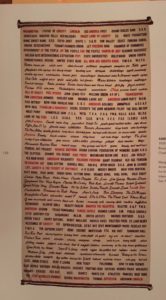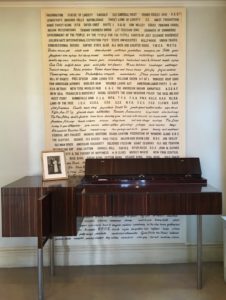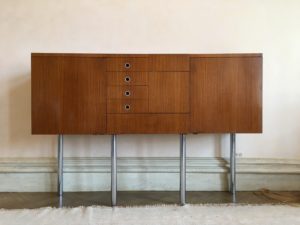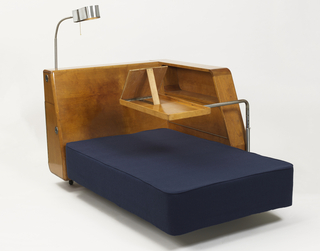This stylishly and supremely practical day bed reflects a collaboration between Frederick Kiesler and Marguerita Mergentime. It was created for Mergentime’s NYC apartment in the mid-1930s, and is Kiesler’s only known residential commission. Containing three storage compartments, a bookshelf, a swing-out bed tray for reading or eating, and an attached lamp, the bed is really a multifunctional living environment.
Frederick Kiesler was an Austrian-born architect, designer and visionary who emigrated to the United States in 1926. He quickly joined the New York design world of the late 1920s and was one of the founders in 1928 of the American Union of Decorative Arts & Craftsmen (AUDAC). In New York his path crossed with Mergentime, who was making a name for herself through her fresh, funky, vivid textile designs, particularly for table linens.
Kiesler specialized in designing department store displays, theatrical sets, exhibitions, and commercial architecture (1), and was responsible for the design of the theater section of the Austria Pavilion at the 1925 Paris Exposition of Industrial and Decorative Arts. His early work in the United States emphasized the flexibility and multifunctionality that defined his furniture design for Mergentime. In later years his design became more philosophical, biomorphic and conceptual, as he ventured into theories of Correalism, worked (endlessly!) on his Endless House (intended as a living unit shaped by the forces of life), and posited, in 1949, that “Function follows vision. Vision follows reality.” (2)
Marguerita Mergentime, a native New Yorker, was also an early member of AUDAC, where her colleagues included such design luminaries as Frank Lloyd Wright, Eliel Saarinen, Russel Wright, Donald Deskey, Ilonka Karasz, and others. AUDAC, founded in 1928, was a short-lived but influential organization, whose members had to be actively involved in industrial production. (3) In its short life, however, AUDAC published Modern American Design (1930) and mounted two exhibitions, at the Grand Central Palace in 1930 and the Brooklyn Museum in 1931. Mergentime exhibited at both exhibitions in her role as a designer for the Keinert Rubber Company. (4)
Selected by Donald Deskey in 1932 to participate in furnishing Radio City Music Hall, Mergentime designed curtains and wall coverings for the main Ladies’s Lounge as well as a cubist-inspired carpet that included line drawings of performers. She exhibited at three World’s Fairs, including the 1939 Golden Gate International Exposition in San Francisco, for which she designed the amazing red, white and blue “Americana” cloth containing 360 Americanisms from colloquialisms to phrases or words from documents such as the Declaration of Independence, the U.S. Constitution, and the Gettysburg Address.

Mergentime’s table linens and other textiles were produced throughout the 1930s and sold at Macy’s, Lord & Taylor and department stores across the country (5). Dismayed by the limited and insipid offerings of the time, she created bold and colorful table linens, showing sailing motifs, huge polka dots, leaves, constellations, and many flowers including her famous Jolly Geranium design. One design contained quiz questions about food – the package came with a pamphlet containing the answers! She created a tablecloth that showed the signatures of all the U.S. Presidents, and sent one of these to Eleanor Roosevelt, receiving a polite thank-you letter from the First Lady. Her interest in civics was reflected in her 1936 “Food for Thought” tablecloth: it contained 98 political slogans in scores of different fonts, and came with a booklet identifying the slogans. (6).
In the early 1930s, as part of her move to a duplex apartment in the San Remo apartment building at West 74th Street and Central Park West, Mergentime commissioned Kiesler to design the furniture for the apartment. In addition to this bed, we can see (in the images below) a three-legged sideboard or cocktail cabinet, and a dresser or “gentleman’s bureau;” both of these reflect a clear interest in logical, organized storage, and this interest is mirrored in the bed in the CH collection.


Kiesler also created seating furniture, bookshelves, and a range of tables for the San Remo apartment. It is unclear when the furniture was actually produced, but there was a full-day photo shoot in June 1936. (7)
The standard twin-size bed was one of a pair (the other bed is in the collection of the Israel Museum), though they were originally placed in separate rooms in Mergentime’s apartment. In later use by Mergentime’s daughter, the beds were used together in the master bedroom. Mergentime’s granddaughter recalls playing on the beds with her brother in her parents’ bedroom; the set was like a home jungle gym, and she recalls stashing objects in the various storage elements (including herself, in the big pillow storage cupboard!), just as she recalls hiding things in the various compartments of the sideboard. (8)
Kiesler, who might today be called a trans-disciplinary figure, worked until the mid-1960s. One of his last architectural commissions was the Shrine of the Book in Jerusalem, to house the Dead Sea Scrolls, completed shortly before his death in 1965. Mergentime’s life and career were sadly cut short by her early death in 1942, resulting in the loss of a vibrant creative figure. But the furniture resulting from their collaboration lives on, defining practicality and multifunctionalism to this day.
Elizabeth Scheuer is a graduate of Cooper Hewitt/Parsons MA program in the History of Design and Curatorial Studies. She teaches a course in Design History at Purchase College, SUNY, and is a docent at Cooper Hewitt, Smithsonian Design Museum.
- Monika Pessler & Harald Krejci, Editors. Friedrich Kiesler Designer, Seating Furniture of the 30s and 40s, 15 Kiesler Foundation Vienna, Berlin: Hatje Cantz, 2005
- Pessler & Krejci, 11
- Virginia Bayer, Linda Florio, Donna Ghelerter. Marguerita Mergentime: American Textiles, Modern Ideas, 11.New York: West Madison Press LLC, 2017
- Bayer et al., 13
- Bayer et al., 34
- Bayer et al., 21
- Gerd Zillner, Curator. Designing Tomorrow: Freidrich Kiesler’s Mergentime Apartment. Frederick and Lillian Kiesler Private Foundation, Vienna. Exhibition: November 9, 2016-February 17, 2017. [No pagination]
- Conversation with Mergentime’s granddaughter, May 1, 2017

One thought on “A Bed for Living”
Peggy Friedland on February 26, 2019 at 10:13 am
This was a wonderful opportunity to learn about Kiesler and Mergentime. The audio component is a great idea—only, I wish the commentator had pronounced the name Mergentime correctly!!!
The ‘g’ is hard/ Merg—as in berg,
not soft, as your announcer said it/Merge—as in merge